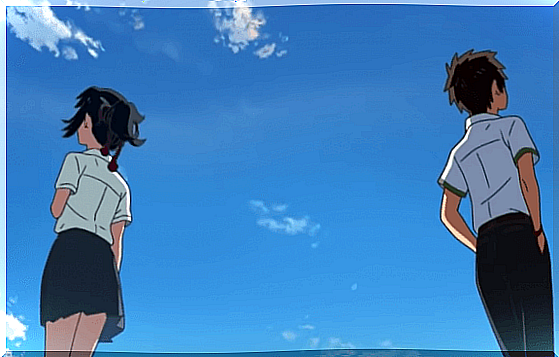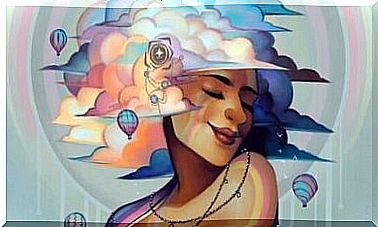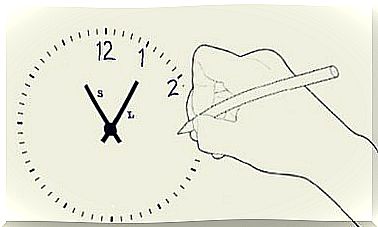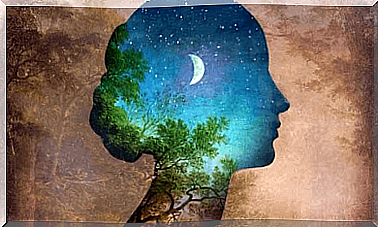Your Name: Tradition, Modernity And Mythologies

Your name is a Japanese animated film that was released in 2016. Makoto Shinkai is the author of the novel that inspired the film, which he also directed.
Your name is, to date, the Japanese animated film with the most admissions. It has also received much praise from specialist critics. But what is the reason for its enormous success?
It is true that Your name is a film which can captivate almost all types of spectators. Even those who don’t necessarily appreciate animated films can appreciate the experience of watching it.
In fact, if we see the film from a Western perspective, we won’t be able to capture its full meaning. Beyond the love story or connection between two young people, Your name is a sample of elements that configure the mythology of Japan. This is why the film acquires greater transcendence for the public of the country.
However, even if we don’t understand the full magnitude of the message lurking deep within the film, a universal story will catch up with us and envelop us. It is important not to fall into skepticism before seeing the film. Indeed, very often, we let ourselves be too guided by appearances and reject audiovisual content without even giving it a chance.
Yes, the protagonists of Your name are two teenagers, but the film does not attempt to portray this stage or delve into the problems of this period of life. It is also not an animated film reserved for children or young people. It is based on a good script and, of course, on exceptional images. The animation looks like photography and blends into the story.
Your name, between tradition and modernity
The film begins with the introduction of Mitsuha, a young teenage girl who lives in a small village called Itomori. Tired of the boring village life and its traditions, Mitsuha would like to be a boy who lives in Tokyo.
Desires, even if they seem totally outlandish, can sometimes come true. Mitsuha will begin to have strange dreams in which she abandons her body and rural life to incarnate in Taki, a young boy who lives in Tokyo.
We quickly find out that Taki actually exists and that these dreams are actually an exchange between the two. In other words, Taki sometimes wakes up in Mitsuha’s body and vice versa.
Discussions are taking place more and more frequently and young adolescents are starting to leave messages on their phones with directions for their daily lives. There is still room for the fantastic in the real world.
The fact that things like new technologies are appearing only reinforces this vision. The real and the fantastic merge before our eyes. This series of exchanges supposes, in turn, a connection with the dream world, the world of the night. Everything is possible in the universe of dreams and the most magical moments take place at night.
Traditions
In many traditions, the time of twilight is associated with magical or supernatural events. This fine light which separates day from night is seen as a line or a door between several worlds. A moment when the real can be combined with fiction, or life can be combined with death. In fact, in the movie we see that the idea of twilight is mentioned a lot.
In Itimori, ancestral traditions are still deeply rooted. We see Mitsuha preparing sake as his ancestors did, that is, chewing the grains of rice and then spitting them out and letting them rest. In Japanese tradition, this drink was prepared for young virgins and had certain magical connotations. In the animated film, he associates himself with the idea of the gods.
On screen , the two main locations, Tokyo and Itomori, are extremely revealing. Tokyo is one of the most modern and technological cities in the world but is located in a country attached to its traditions and ancestral culture.
We often forget this culture and associate the idea of Japan with the city of Tokyo. However, Japan is much more than one big city. Mitsuha herself has a totally idealized image of the big city and rejects her origins.
Your name combines tradition and modernity; he pushes them to cross paths through his characters and the particular story he tells us. Beyond the exchange of bodies, the plot takes a new direction when the two protagonists say they want to know each other. At this point in the story, the adventures will take on new meaning and lead us to a quest for the impossible.

The legend of the red thread
In the realm of the fantastic, the impossible can happen. However, it is important to keep a likelihood. Your name presents some elements which are nevertheless not plausible and can create confusion for the viewer. The jumps from one scene to another create an effect of strangeness and we can find several voids in the frame.
The film fills these “holes” by relying on Japanese mythology, on the element of magic and fantasy. Your name is worth seeing for the high quality of its animation and for those scenes so detailed that sometimes make us think of photographs. The story is neither logical nor rational, but it appeals to feelings, magic and love.
In the Eastern tradition, there is an ancestral legend that connects people through a red thread. An imperceptible thread, which cannot be broken: you can wind it, stretch it… It will never break. It accompanies people from birth and connects them for eternity. No matter what happens, and no matter the distance: the people on either end are meant to meet.
We do not speak directly of this legend in the film but it appears from the beginning. One of Itomori’s most ancient traditions is rope weaving. Mitsuha still has a red rope on her and will throw it at Taki at some point. Through the rope, reminiscence will occur; it is this idea of being faced with something that you know at another time or place.
In the West, the idea of soul mates is perhaps more familiar to us. However, even though we are not familiar with oriental legends, the presence of the red thread in the film is very visual. It reminds us of a connection between the protagonists. A connection that can overcome barriers of space and time and create a new destiny that seemed impossible.
Your name , the universality of love
A story of such magnitude, told through the eyes of two teenagers, could easily have fallen into a cutesy register. However, the film tells us a universal story to demonstrate that, even in the most artificial and technological world there is, there will always be a place for love and feelings.
The beauty of the images accompanies this idea to create a poetic atmosphere. It makes us forget the initial confusion in order to deepen certain feelings. The magic of the stars, nature, the universe and contact with the spiritual world are manifested by making us forget, for a few moments, our usual skepticism.
We can add to that the very interesting initial point of view, of putting yourself in another person’s shoes and “seeing the world through the eyes of another”. Mitsuha wants to run away from Itomori as Taki falls in love with the beauty of the place. And, similarly, the young man is barely aware of the possibilities of a city like Tokyo, while Mitsuha sees opportunities on every corner. Because the world changes from our perspective.
Your name also leaves room for a few moments of humor that break the softness of the film a little. It thus brings a certain realism so as not to water down the frame too much. Dreams, feelings, imagination and youth give shape to a film which, even though it is filled with mythology and traditions, sends us a universal message.










